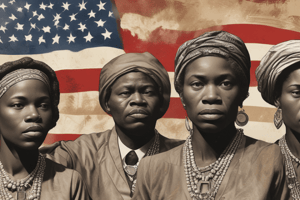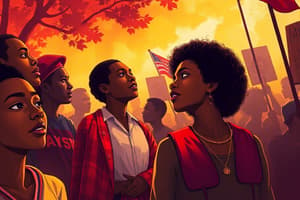Podcast
Questions and Answers
In response to the Brown decision, they issued the Southern ______, pledging resistance to court orders for integration.
In response to the Brown decision, they issued the Southern ______, pledging resistance to court orders for integration.
Manifesto
An example of nonviolent protest was the ______ Bus Boycott, initiated in 1955 following Rosa Parks' refusal to give up her bus seat for a white passenger.
An example of nonviolent protest was the ______ Bus Boycott, initiated in 1955 following Rosa Parks' refusal to give up her bus seat for a white passenger.
Montgomery
The movement reached its peak with the March on Washington for Jobs and ______ in August 1963.
The movement reached its peak with the March on Washington for Jobs and ______ in August 1963.
Freedom
The Civil Rights Act of 1964 and the Voting Rights Act of 1965 banned discrimination based on race, color, religion, sex, or ______ origin.
The Civil Rights Act of 1964 and the Voting Rights Act of 1965 banned discrimination based on race, color, religion, sex, or ______ origin.
As a result of the obstinacy of the white power structure in the South, elements of the movement shifted towards ______ power ideologies and militant actions.
As a result of the obstinacy of the white power structure in the South, elements of the movement shifted towards ______ power ideologies and militant actions.
While significant progress was achieved during this era, ongoing ______ persist to ensure the complete realization of civil rights for all citizens.
While significant progress was achieved during this era, ongoing ______ persist to ensure the complete realization of civil rights for all citizens.
Civil rights activism can trace its roots back to the post-______ era.
Civil rights activism can trace its roots back to the post-______ era.
The ______ Act of 1865 abolished slavery throughout the United States.
The ______ Act of 1865 abolished slavery throughout the United States.
Despite constitutional ______, African Americans faced poverty, inequality, and denial of political rights and freedoms.
Despite constitutional ______, African Americans faced poverty, inequality, and denial of political rights and freedoms.
One notable approach was centered around the ______.
One notable approach was centered around the ______.
The ______ Association for the Advancement of Colored People (NAACP) spearheaded the strategy to challenge the legal foundation of Jim Crow segregation.
The ______ Association for the Advancement of Colored People (NAACP) spearheaded the strategy to challenge the legal foundation of Jim Crow segregation.
Brown v. ______ of Topeka declared segregated facilities inherently unequal.
Brown v. ______ of Topeka declared segregated facilities inherently unequal.
Flashcards are hidden until you start studying
Study Notes
Civil Rights Movements
In the mid-twentieth century, a wave of civil rights movements swept across the United States, demanding equal rights for African Americans. This era saw various forms of peaceful resistance and calls for legislative changes to combat discriminatory practices.
Origins and Legal Challenges
Civil rights activism can trace its roots back to the post-Civil War era, where abolitionists worked towards ending racial injustice and eradicating slavery. The Civil Rights Act of 1865, which abolished slavery throughout the United States, marked a legal victory in this struggle. However, racial segregation known as Jim Crow soon emerged in the South. Despite constitutional amendments guaranteeing equal rights, African Americans faced poverty, inequality, and denial of political rights and freedoms.
Strategies and Approaches
Throughout history, civil rights activists employed a diverse range of strategies, from bringing lawsuits in court to mass direct action and black power movements. One notable approach was centered around the Supreme Court. Spearheaded by the National Association for the Advancement of Colored People (NAACP), this strategy aimed to challenge the legal foundation of Jim Crow segregation through landmark cases like Brown v. Board of Education of Topeka, which declared segregated facilities inherently unequal.
However, white supremacists in the South resisted desegregation efforts. In response to the Brown decision, they issued the Southern Manifesto, pledging resistance to court orders for integration.
Nonviolent Protest and Civil Disobedience
As authorities in the South actively defied court orders, leaders within the Civil Rights Movement turned to nonviolent protest and civil disobedience tactics. An example of this was the Montgomery Bus Boycott, initiated in 1955 following Rosa Parks' refusal to give up her bus seat for a white passenger. Martin Luther King Jr. emerged as a leader in this effort, which provided a blueprint for subsequent protests.
Milestones and Legislation
The movement reached its peak with the March on Washington for Jobs and Freedom in August 1963. Hundreds of thousands gathered in Washington D.C. for a peaceful demonstration demanding substantial changes, leading to the passage of the Civil Rights Act of 1964 and the Voting Rights Act of 1965. These laws banned discrimination based on race, color, religion, sex, or national origin and prohibited race-based restrictions on voting.
Black Power and Continued Struggle
Despite legislative victories, the obstinacy of the white power structure in the South convinced some black activists that nonviolent civil disobedience alone could not bring about lasting change. As a result, elements of the movement shifted towards black power ideologies and militant actions.
In summary, the Civil Rights Movement encompassed a wide array of strategies and approaches aimed at securing full political, social, and economic rights for African Americans. While significant progress was achieved during this era, ongoing struggles persist to ensure the complete realization of civil rights for all citizens.
Studying That Suits You
Use AI to generate personalized quizzes and flashcards to suit your learning preferences.




